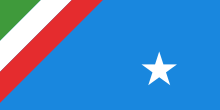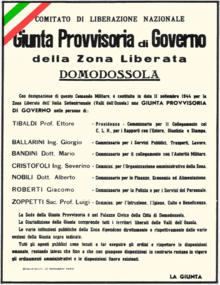Partisan Republic of Ossola
The partisan republic of Ossola ( Italian: Repubblica dell'Ossola ) was a “liberated zone” ( zona liberata ) founded by partisans for 44 days (from September 10 to October 19, 1944 ) in northern Italy with Domodossola as the “capital”.
geography
The area covered the entire Val d'Ossola , bounded in the west by the border with the canton of Valais , in the east by the border with the canton of Ticino and in the south by a line over the southern mountain range of Valle Anzasca , the upper Valsesia , Ornavasso to Mergozzo with an area of approx. 1600 km² and around 82,000 inhabitants. An exception was the area around Cannobio , which, after a week of independence, was taken back by a 2,000-strong German force on September 9th .
history
founding
After various armed partisan organizations of different political stripes succeeded in routing the German occupation forces and Italian fascists, the Republic of Ossola was proclaimed on September 10 in Domodossola, near the Swiss border. On September 12, the National Liberation Committee (CLN) announced the members of the Provisional Government.
Innovations
As a result, public life was reorganized based on innovative ideas that were not limited to normal administration. Parliaments were set up and village councils set up. A newspaper, emergency money and stamps were issued. The distribution and rationing of food and relief supplies had to be reorganized.
The reorganization of the judiciary was tackled by the socialist lawyer Ezio Vigorelli . It should be based on democratic principles and also guarantee the rights of the accused. The prisoners in Druogno in Val Vigezzo were treated without harshness, as the Tribune de Genève is said to have confirmed.
In the educational system, anti-fascist intellectuals like Gianfranco Contini developed demanding programs. There were plans for the promotion of basic general education and for a progressive separation between high school education and vocational training. However, given the republic's short span of time, many projects had to remain on paper.
The brief social and political self-government experiment in the largest liberated zone in Italy is considered to be the democratic nucleus of the later Italian republic.
Recapture
The partisan formations were only able to successfully resist the Avanti reconquest operation, launched on October 9, 1944 by the German Wehrmacht with the support of Italian fascists . On October 18, a border incident ( Battaglia dei Bagni di Craveggia ) occurred at the spa of Bagni di Craveggia at the end of the Onsernone valley , when the commander of a German-Italian unit demanded the extradition of the “bandits” from the small Ticino border post and with the invasion after Spruga in Switzerland. A reinforced Swiss grenadier company quickly rushed to inform him that no refugees were being extradited and that an attack would be resisted by force of arms. The fascist unit then withdrew. On October 21, the last line of defense fell in Val Formazza.
Escape to Switzerland
From 1943 to 1945 around half of the population (15,000 civilians, 30,000 partisans) - 35,000 of them in the last few days (October 12-22, 1944) of the Republic of Ossola - fled to the Swiss cantons of Valais and Ticino. The Swiss Workers' Relief Organization (SAH) commissioned Margherita Zoebeli and Gabriella Meyer on October 9, 1944, to organize the crossing of the border for fleeing partisans and civilians in the upper Val d'Ossola (Val Formazza ). The adults found accommodation in refugee camps, and 2,500 children between the ages of 5 and 13 were distributed to host families throughout Switzerland through the agency of the Swiss Red Cross Children's Aid .
literature
- Hubertus Bergwitz: The partisan republic of Ossola . Publishing house for literature and current affairs, 1972.
- Paolo Bologna: Il paese del pane bianco. Testimonianze sull'ospitalità svizzera ai bambini della repubblica dell'Ossola . Grossi Verlag, Domodossola 1994, ISBN 978-88-85407-36-7 .
- Renata Broggini, Marino Viganò: I sentieri della memoria nel Locarnese 1939–1945. Editore Dadò, Locarno 2004, ISBN 978-88-8281-133-4 .
- Gino Vermicelli: The invisible villages. Partisans in the Ossola Valley . Rotpunktverlag, Zurich 1990. ISBN 3-85869-049-X .
- Dieter Dehm: Bella ciao , Das Neue Berlin , 2007, ISBN 978-3-360-01292-0 . (Novel about the partisan republic of Ossola and the song Bella ciao .)
Web links
- Holger Fröhlich: The mountain is our only friend. In: Greenpeace Magazin , January 2017
- Mirko Schwanitz: Forgotten Partisan Republic: The 40 Days of Ossola. In: deutschlandfunk.de , Das Feature , September 6, 2016
- Ossola Valley on gedenkorte-europa.eu, the homepage of Gedenkorte Europa 1939–1945
- Ticino aid for Italian partisans. Memory of the «Repubblica dell'Ossola». In: nzz.ch , October 4, 2004
- Gerhard Lob: Ceremony in Domodossola. Thanks to the Swiss friends. In: swissinfo.ch , October 2, 2004
- Edgardo Ferrari: Voce del Cifr: Le Repubbliche del 1944 ( Memento of September 14, 2013 in the Internet Archive )
Individual evidence
- ^ Hubertus Bergwitz: The partisan republic of Ossola . Publishing house for literature and current affairs, 1972, p. 16 .
- ↑ isrn.it: Istituto storico della Resistenza e della società contemporanea nel Novarese e nel Verbano Cusio Ossola
- ^ Antifa Bern: On the way in the former partisan republic of Ossola , pp. 162–169
- ^ Associazione Nazionale Partigiani d'Italia (ANPI) : ciclo iniziale di formazione comune a tutti , accessed on January 5, 2014.
- ^ Associazione Nazionale Partigiani d'Italia (ANPI) : successiva distinzione tra studi liceali e studi tecnico-professionali , accessed on January 5, 2014.
- ^ Associazione Nazionale Partigiani d'Italia (ANPI): La Repubblica della Val d'Ossola
- ^ La Battaglia dei Bagni di Craveggia. In: Ticinarte.ch
- ^ Ticino aid for Italian partisans. Memory of the “Repubblica dell'Ossola”. In: NZZ , October 4, 2004, accessed December 15, 2013.

